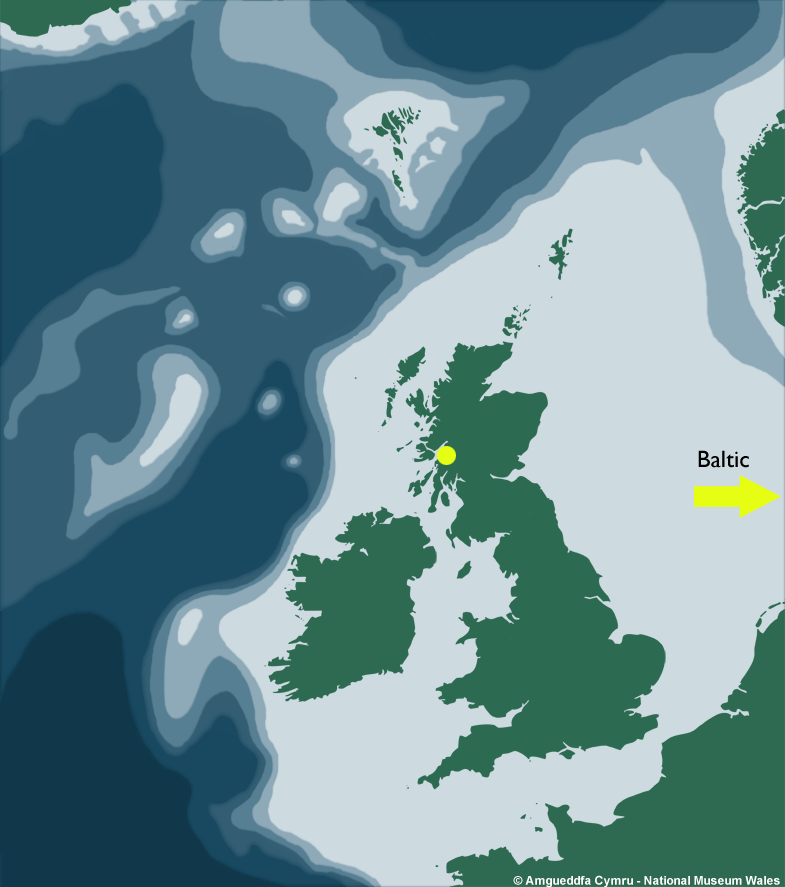Mytilus trossulus Gould, 1850
Mytiloidea : Mytilidae |
| Tebble name: | n/a |
| Smith & Heppell name: | n/a |
Outline:
As
Mytilus edulis
, see key features for distinguishing characters.
Distribution & Ecology
In our study area known only from Loch Etive. The population is suggested to be post-glacial relict restricted to the low salinity area of the Loch.
Native to the Pacific Ocean. Found also in Barents Sea, Canadian Atlantic and Baltic Sea.
Depth Range
Intertidal
Continental Shelf (to 200m)
Native to the Pacific Ocean. Found also in Barents Sea, Canadian Atlantic and Baltic Sea.
Depth Range
Intertidal
Continental Shelf (to 200m)

Additional Information & Related Species
Key Features & Similar Species
As Mytilus edulis but the shell is described as paddle-shaped, that is with the dorsal margin more or less parallel with the ventral margin. The shell is thin, rather flexible and has distinct concentric corrugations over the posterior area. These morphologically distinct shells are genetically pure trossulus type or hybrid trossulus x edulis.
Additional Comments
Author(s): Beaumont, Andy R. (a.r.beaumont@bangor.ac.uk); Hawkins, Marie P.; Doig, Fiona L.; Davies, Ian M.; Snow, Michael
Source: Journal of Experimental Marine Biology and Ecology Volume: 367 Issue: 2 Pages: 100-110 Published: December 15 2008
Abstract: Three species of the mussel, Mytilus, occur in the North Atlantic region, M. edulis, M. galloprovincialis and M. trossulus, and hybrid zones are present where their distributions overlap. M. edulis is a native species in the UK. M. galloprovincialis originated in the Mediterranean and its distribution extends northwards along the Atlantic seaboard to Scotland. Baltic Sea mussels have a M. trossulus ancestry but are highly introgressed by M. edulis. In recent decades, farming of mussels on long-line rope culture systems has been introduced into Scotland. On farms in Loch Etive, a form of mussel with a fragile shell and a different shape to either M. edulis or M. galloprovincialis has been increasing in frequency over recent years. Samples of fragile shelled, normal strong shelled and intermediate mussel types were sampled from two farms in 2006 and compared with samples of M. edulis, M. galloprovincialis and M. trossulus from other sources where their species identity is well established. Abundance relative to depth, shell strength, condition index and shell morphology were analysed together with 5 allozyme loci and one nuclear DNA genetic marker (Me 15116). The fragile shelled mussels, and many of those classed as intermediate, were identified as a mixture of M. trossulus and M. trossulus x M. edulis hybrids. This identification was strongly supported by both morphological and genetic data and is the first record of the presence of M. trossulus in UK waters. M. trossulus in Loch Etive are most likely to be a post-glacial relict population restricted to the low salinity area of the Loch that has recently increased in abundance due to commercial mussel growing activity. In addition, individual mussels of all three species and their hybrids were detected amongst Loch Etive mussels. This is the first genetic demonstration of all three species and their hybrids occurring together in one location in the Atlantic region and provides a unique opportunity to study the processes of speciation, divergence, and introgression in the genus Mytilus.
Source: Journal of Experimental Marine Biology and Ecology Volume: 367 Issue: 2 Pages: 100-110 Published: December 15 2008
Abstract: Three species of the mussel, Mytilus, occur in the North Atlantic region, M. edulis, M. galloprovincialis and M. trossulus, and hybrid zones are present where their distributions overlap. M. edulis is a native species in the UK. M. galloprovincialis originated in the Mediterranean and its distribution extends northwards along the Atlantic seaboard to Scotland. Baltic Sea mussels have a M. trossulus ancestry but are highly introgressed by M. edulis. In recent decades, farming of mussels on long-line rope culture systems has been introduced into Scotland. On farms in Loch Etive, a form of mussel with a fragile shell and a different shape to either M. edulis or M. galloprovincialis has been increasing in frequency over recent years. Samples of fragile shelled, normal strong shelled and intermediate mussel types were sampled from two farms in 2006 and compared with samples of M. edulis, M. galloprovincialis and M. trossulus from other sources where their species identity is well established. Abundance relative to depth, shell strength, condition index and shell morphology were analysed together with 5 allozyme loci and one nuclear DNA genetic marker (Me 15116). The fragile shelled mussels, and many of those classed as intermediate, were identified as a mixture of M. trossulus and M. trossulus x M. edulis hybrids. This identification was strongly supported by both morphological and genetic data and is the first record of the presence of M. trossulus in UK waters. M. trossulus in Loch Etive are most likely to be a post-glacial relict population restricted to the low salinity area of the Loch that has recently increased in abundance due to commercial mussel growing activity. In addition, individual mussels of all three species and their hybrids were detected amongst Loch Etive mussels. This is the first genetic demonstration of all three species and their hybrids occurring together in one location in the Atlantic region and provides a unique opportunity to study the processes of speciation, divergence, and introgression in the genus Mytilus.
Related Species
Mytiloidea : Mytilidae
References
Listed are literature citing Mytilus trossulus Gould, 1850. Reference containing the species Type Description is highlighted.
|
Beaumont AR, Hawkins MP, Doig FL, Davies IM & Snow M 2008. Three species of Mytilus and their hybrids identified in a Scottish Loch: natives, relicts and invaders?. Journal of Experimental Biology. 367 (2): 100-110. |
|
Gould A A 1850. The following shells from the United States Exploring Expedition were described by Dr Gould. Proceedings of the Boston Society of Natural History. 3: 343-348. |
Resources
- Conchological Society
of Great Britain & Ireland
Provides resources for understanding, identifying, recording, and conserving molluscs - CLEMAM
Check List of European Marine Mollusca - MarLIN
The Marine Life Information Network for Britain and Ireland (MarLIN) provides information for marine environmental management, protection and education. It is a centre of excellence in spatially based and time-series marine biological information and supports good stewardship in the marine environment. - NBN Gateway
National Biodiversity Network's Gateway. Use it to explore UK biodiversity data, as contributed by participating data providers. - BivAToL
- MarBEF
- Malacological Society
- Unitas Malacologica
- Census of Marine Life
- MarBEF
MarBEF, a network of excellence funded by the European Union and consisting of 94 European marine institutes, is a platform to integrate and disseminate knowledge and expertise on marine biodiversity, with links to researchers, industry, stakeholders and the general public.
Record last modified: 22/03/2016









